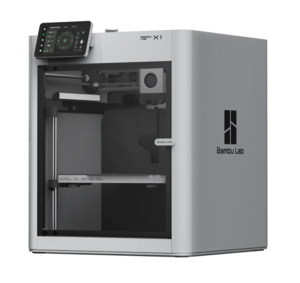Difference between revisions of "Bambu"
(Created page with " Bambu Lab X1 Carbon == Getting started with 3D printing on the Bambu Lab X1 Carbon == If this is your first time 3d printing we recommend...") |
(No difference)
|
Latest revision as of 15:35, 27 November 2023
Contents
Getting started with 3D printing on the Bambu Lab X1 Carbon
If this is your first time 3d printing we recommend using our Ultimakers instead.
3D printing with the Bambu is fast, cheap, and a fun experience based on FDM technology. However, it is easy to make mistakes due to hardware or software setup. The following article is supposed to give you as a user, the necessary background for getting started with rapid prototyping and 3D printng with the Ultimakers.
The Bambu X1 Carbon is our most advanced FDM printer. We estimate it prints 6 times faster than the Ultimaker 2+.
Required Safety Equipment
None
Hazards
Guidelines
- Do not use the printer unless you know how to use it.
- Print only in 1.75 Filament.
- Do not tamper with the 3D printer.
- Do not connect to the printer through wifi or bluetooth
- If you want instruction, have trouble with the printer or we are running low on materials, contact the engineer here.
- Always follow the SOP outlined bellow.
Standard Operating Procedure
The workflow in any prototyping using 3D printers is:
1. Retrieve/create a 3D model
You can fetch files from creator spaces such as Thingiverse or model them your self, using a CAD tool such as Fusion360, SolidWorks or Blender.
The next step requires the file format of your model to be either .3mf or .stl.
2. Generate toolpaths for the 3D printer
The tool for generating toolpaths for 3D printers is called a slicer. For Bambu printers we use Bambu Studio. A quick guide to Bambu studio can be found here.
The standard preset grants high detailed results and short printing time. You can tweak the print settings as you see fit. as long as it's in accordance with our 3D printing guidelines. I.e. Total printing time should not exceed 1 day (24 hours). Infill should not exceed 20%.
This process is called slicing. This gives you a .gcode file. Save this file onto a micro SD card and insert it into the printer.
3. Prepare the build plate
Remove any debris that may be on the plate. If the bed is starting to get dirty, rinse it with lukewarm water. The water will dissolve the leftover glue on the build plate.
Make sure that you are using the correct build plate. The cold plate is only suited for printing PLA, as indicated on the cold plate. For engineering materials such as PETG, flip the build plate over to reveal the engineering plate side. Likewise do not print PLA on the engineering plate.
Apply glue on the area of the build plate where your first layer will adhere. This provides a strong bond between the build plate and the first layer. It also makes the print easier to remove from the build plate after it is finished.
4. Double check the filament
Make sure that the type of filament on the spool holder corresponds to the material defined in your slicer and on the 3d printer itself. A mismatch may cause your print to fail.
Make sure that there is enough material remaining. In your slicer you will get an estimate of how many grams of filament is required for the print. On the side of the filament spool there is an indicator estimating amount of remaining filament. Should you run out of material during printer, the printer will pause and you may add another spool of filament.
5. Consider if your print requires auto-calibation
When starting a print, Consider wether you want the printer to auto-calibrate before printing. The entire auto-calibration sequence takes 5 minutes and isn't always necessary for smaller parts.
You may also choose if you want a timelapse of your print at this stage. The timelapse will be stored on the sd-card.
6. Remove yor print from the printer
The build plate is fixed to the printer magnetically, making it easy to remove. To remove your part from the build plate, simply bend the build plate gently and your print should pop of.
Do not use a metal scraper tool! The cold plate is easily damaged by sharp metal edges. If necessary us a plastic scraper instead.
7. Post processing your part
Arguably the most boring part of 3d printing. Break of supports, peal off brims. Tidy up the print with a knife and/or sandpaper. 3D printed parts are well suited for painting.
8. Tidy up after you
Dispose of supports and other leftover parts of your print in the designated bin. Replace all tools to their proper home. Clean the buildplate with lukewarm water if necessary and replace it in the printer.
Filament
Though we mainly print in PLA filament from Polymaker. The Bambu lab X1 carbon was designed with printing engineering materials in mind.
The X1 Carbon only supports 1.75mm diameter filament.
Errors
If a print goes wrong, do the accordingly:
- Check setup in Bambu Studio and on the printer.
- Rewash the bed level.
- Calibrate the printer.
If this does not help, please notify the engineer here.
Clog
Clogging of the nozzle typically occurs when the workpiece has tilted due to overhang, wrong settings in Bambu Studio, or wrong filament type. A solution to clogged nozzle is using the Atomic Method



